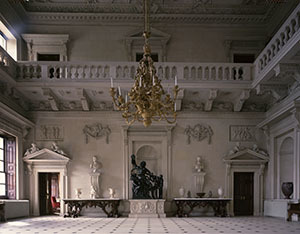The Houghton Emperors
I promise that this will be the last imperial post for a while. But I do want to give you a glimpse of a wonderful little show at the Fitzwilliam Museum in Cambridge ��� displaying a pair of splendid busts of Commodus and Septimius Severus that usually stand in the Stone Hall at Houghton Hall in Norfolk, decorated under the eye of Robert Walpole. (You can just see them in the pic above, on either side of Laocoon.)
They actually belong to the Fitzwilliam ��� in the sense that they were accepted by the government in lieu of death duties a few years ago, formally allocated to the Fitz, but in practice left where they had actually been for 300 years alongside other antiquities acquired for Walpole and a variety of eighteenth-century copies and pastiches (including a splendid Rysbrack of Walpole himself in Roman guise). The human equivalent would be to say that the Fitzwilliam has custody, Houghton has care and control.
Anyway, they have come for a brief visit to Cambridge, where it is interesting to see them in a completely different setting ��� and next to a Rysbrack terracotta version of the Walpole portrait bust.
And partly to celebrate that, the museum hosted an evening discussion on Friday ��� a ���conversation��� between Lucilla Burn (recently retired keeper of antiquities there, and the organiser of the show) and me, combined with a viewing of the emperors concerned.
We started off talking about the ancient context of the pieces, and how they were identified at Commodus and Septimius Severus. It���s a huge hornets nest, to be honest ��� all depending on how far you see imperial portraits as the result of a centralized operation, pouring out the official version of the emperor across the empire to subjects who would never see him in the flesh. Some of it must have been centralised (else how do you explain the fact that very similar portraits, right down to the locks of the hair, are found on different sides of the Roman world?); but how much? And if it was, why do we hear absolutely nothing about it in any written evidence at all?
But towards the end, we got onto the eighteenth-century context, and that old favourite topic of how to understand the Roman-style dress in which so many of these busts are apparently clad. I���ve read a lot more about this than I had when I first began to think about it (and I got a huge amount out of Malcolm Baker���s Marble Index, if you are looking for bibliography). But I���m still interested in that transition, some time in the first half of the nineteenth century, when the toga went from seeming a ���natural��� way to present someone, to being more like fancy dress.
More later!
(And here is the version we shall soon be fully migrating to...
http://www.the-tls.co.uk/the-houghton...
...have to say I am quite looking forward to not having to do two versions of each post)
Mary Beard's Blog
- Mary Beard's profile
- 4072 followers





